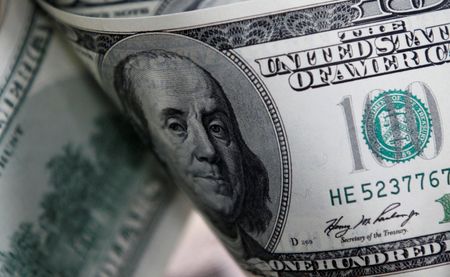By Ankur Banerjee and Amanda Cooper
SINGAPORE/LONDON (Reuters) -The U.S. dollar held firm on Thursday in a volatile week as investors contend with a fragile bond market and data showing a weakening labour market, which has reinforced expectations the Federal Reserve will cut rates this month.
With the Fed focused on employment, Friday’s crucial jobs report will help set expectations for the central bank’s next few policy meetings. Data on Wednesday showed job openings fell to a 10-month low in July, although layoffs remained relatively low. Separate surveys on private sector employment and monthly layoffs are due later on Thursday.
Traders are pricing in a near-100% chance of the Fed cutting interest rates later this month, up from 89% a week ago, CME FedWatch showed. They are also pricing in 139 basis points of easing by the end of next year.
The dollar edged up in relatively steady trade, reflecting investor wariness of making any big moves ahead of Friday’s payrolls report.
The euro edged down 0.14% to $1.1645, as did sterling,, down 0.1% at $1.344, just above Wednesday’s four-week lows.
The dollar index, which tracks the U.S. currency against six others, was up slightly at 98.31. The Japanese yen weakened, leaving the dollar up 0.2% at 148.34.
Several Federal Reserve officials said labour market worries continue to underpin their view that rate cuts still lie ahead for the central bank, boosting expectations of an imminent rate cut.
James Knightley, ING’s chief international economist, said the Fed is very likely to cut rates meaningfully in the months ahead with little inflation pressure coming from the jobs market.
“We expect them to cut 25 bp at the September, October and December FOMC meetings,” he said.
The Fed is due to meet on September 16 and 17.
BOND WORRIES
Much of the focus this week has been on the bond market, where yields on long-end notes across the globe have risen as investors become increasingly anxious about the fiscal health of major economies from Japan to Britain and the United States.
“Global bonds recovered some lost ground yesterday providing some temporary relief and helping to stabilise the foreign exchange market,” MUFG currency strategist Lee Hardman said.
A closely watched auction of 30-year Japanese government bonds passed smoothly on Thursday, calming investors’ nerves, while the dovish comments from policymakers triggered a modest rally in Treasuries, pushing yields lower.
U.S. 30-year bond yields were down 1.6 basis points on the day at 4.888%, having hit 5% – the highest in about 1-1/2 months – on Wednesday.
Uday Patnaik, head of Asia fixed income and global emerging market debt in the asset management division of L&G, said the rise in yields reflects poor fiscal conditions in some of the largest advanced economies, where the debt-to-GDP ratio is heading above 100%.
“The problem here is not one of these countries are running a primary surplus, which means revenues cannot even cover non-interest spending,” he said.
“To fix this will necessitate significant cuts in spending or additional revenues, at a time when social and political pressures are running high.”
In other currencies, the Australian dollar fell 0.4% to $0.6518, while the New Zealand dollar dipped 0.3% to $0.5859.
(Additional reporting by Ankur Banerjee in Singapore; Editing by Stephen Coates, Joe Bavier and Hugh Lawson)









